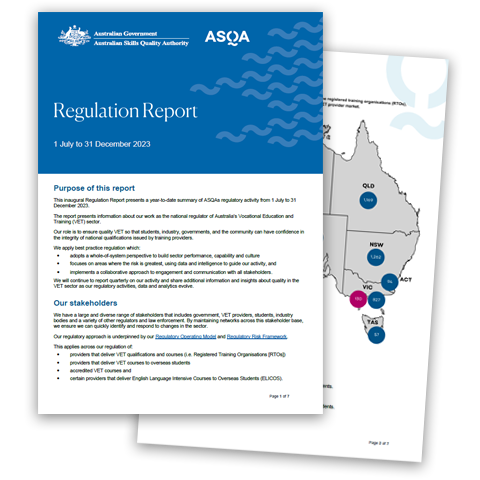- Home
- About us
- ASQA overview
- Working together for better regulation
Working together for better regulation
Timely reporting
Our quarterly Regulation Report presents information collected by ASQA through our work as the national regulator of Australia’s Vocational Education and Training (VET) sector.

Rapid review
On 30 April 2020, the Australian Government released the rapid review into our regulatory practices and processes. This report outlines 24 recommendations to reform the way ASQA operates, in line with best practice governance, regulation and engagement. The report also provides a long-term vision for better regulation for the Australian Vocational Education and Training (VET) sector.
We are commencing a program of work to implement the recommendations of the review. Our program is firmly focused on delivering best practice regulation.
Our overarching goal is to move from input and compliance controls, to a focus on self-assurance and excellence in training outcomes. Improving quality and confidence in the sector is a shared responsibility and ASQA will work with the sector to this end.
With ASQA’s reform occurring in tandem with wider skills reform, our work will be ongoing over the next few years.
As the national VET Regulator, our role is to ensure quality vocational education and training so that students, employers, the community and governments can have confidence in the integrity of training products issued by training providers.
ASQA’s current reform work is part of the broader government vision for VET, as outlined in the Heads of Agreement for Skills Reform, which includes supporting reforms to strengthen standards and build provider capacity through self-assurance.
By working together we aim to foster a culture that focuses on quality, continuous improvement through having robust systems to monitor and evaluate ongoing compliance with the Standards for providers
Our regulatory practice
As part of our response to the Rapid Review, we have improved our approach to deliver best practice regulation.
We have revised our approach to support the 2025 Standards.
Reform implementation
Our reform work is designated into three key areas:
Quality standards
and self-assurance
We're taking a staged approach to promoting a culture of self-assurance and continuous improvement, to support improved training outcomes in the VET sector.
This work is part of a suite of VET quality reforms aiming to improve training outcomes for students and employers.
Find out about our program of work to improve training outcomes in the VET sector.
Related links
Share
